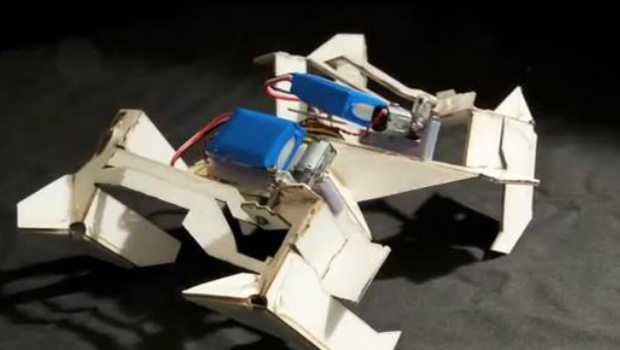It would be strange enough to see a robot fold itself into arbitrary shapes and then just walk away.
Then add to the mix that it’s a laser-cut origami robot and you have the new robotic technology created by a team of engineers from Harvard, the Wyss Institute and MIT.
Engineers at Harvard and MIT have teamed up to create a robot that can assembles itself and walks away. (Video: Harvard)
“The exciting thing here is that you create this device that has computation embedded in the flat, printed version,” Daniela Rus, the Andrew and Erna Viterbi Professor of Electrical Engineering and Computer Science at MIT, said in a statement. “And when these devices lift up from the ground into the third dimension, they do it in a thoughtful way.”
The technology, which mimics the way amino acids fold themselves into complex proteins, demonstrates scientists’ ability to cheaply and quickly build sophisticated robots that can automate their own design and assembly process, according to Harvard.
“Getting a robot to assemble itself autonomously and actually perform a function has been a milestone we’ve been chasing for many years,” said Robert J. Wood, a professor of engineering at Harvard and the Wyss Institute.
The universities contend that this is the first robot that can assemble itself and then perform a function — all without human intervention.
“Imagine a ream of dozens of robotic satellites sandwiched together so that they could be sent up to space and then assemble themselves remotely once they get there,” said Sam Felton, a Harvard doctoral student, who worked on the project. “They could take images, collect data and more.”
Researchers have been working on different pieces of this technology for some time.
In May, MIT’s Rus announced that scientists there had made progress on the promise of 3D printed robots.
Components
The team created printable robotic components that, when heated, automatically fold into three-dimensional configurations. The researchers also figured out how to build electrical components – like resistors and inductors – from these self-assembling materials.
MIT noted that the new self-assembling robotic work is similar, but a network of electrical leads, rather than an oven or hot plate, delivers heat to the robot’s joints to initiate the folding.
“That’s exciting from a geometry standpoint because it lets us fold more things,” said Erik Demaine, an MIT professor of computer science and engineering. “Because we can do the sequencing, we have a lot more control and it lets us make active folding structures. Instead of just self-assembly, you can then make it walk.”
According to MIT, the new robots are created with five layers of materials, all of which are created by a laser cutter. The top and bottom layers are made of polymer, which folds when heated. Those polymer layers hold two layers of paper, which in turn hold the middle layer. That middle layer is made of copper etched into a complex network of electrical leads.
A microprocessor, batteries and tiny motors are attached to the top layer.
Researchers are trying to use either a single, two or four motors. Each motor, which is controlled by the microprocessor, controls two robotic legs.
Computerworld






Subscribers 0
Fans 0
Followers 0
Followers